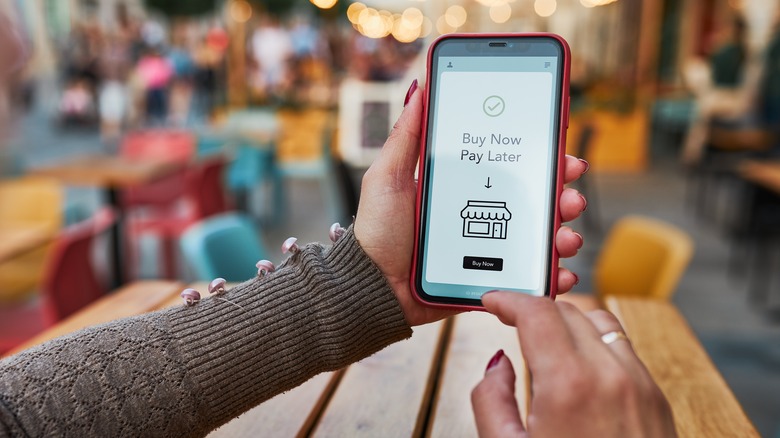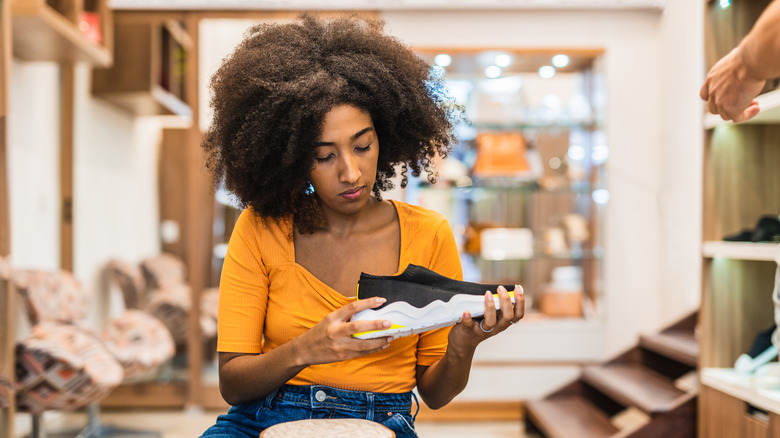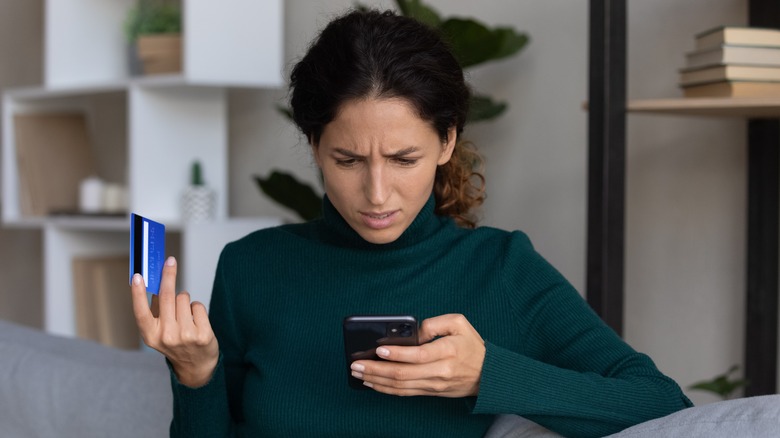How To Avoid The Slippery Debt Slope Of Buy Now, Pay Later
As 19th-century humor writer Josh Billings once wrote, "Debt is like any other trap, easy enough to get into, but hard enough to get out of." Enter: the era of buy now, pay later loans, wherein merchants and various financial and lending companies (including Affirm, Klarna, and Afterpay) team up and offer consumers interest-free equal installment payment plans at the time of the purchase instead of making them pony up for the purchase at all once.
While these plans are eerily reminiscent of those antiquated layaway plans department stores used to offer, they have one significant difference: buy now, pay later users don't actually have to lay the item away behind the counter of said department store until they can cough up the money for the item in full. Instead, they get to take home their treasure the same day. And voila! The consumer gets what they want, and the merchant gets the sale. A win-win, no? Alas, if something seems too good to be true, it usually is, and many financial advisors and experts argue that buy now pay later loans are just that. "Buy now, pay later plans can encourage overspending by obscuring the true cost of the purchase," Ted Rossman, a senior industry analyst for Bankrate.com, told Fox Business.
So how can consumers avoid the slippery slope of buy now, pay later debt? Here are some effective ways to steer clear.
Define your wants and your needs
Is it a want or a need? Perhaps the best way for consumers to avoid accumulating debt through the slippery slope of buy now pay later loans is first to identify whether the purchase is a necessity or merely a want. Did you just land a remote job that requires access to a laptop but you don't have one? That would most likely go into the "need" category. That adorable Chanel bag that costs more than three months' rent? Definitely a want.
"Buy now, pay later makes borrowing money for stupid things way too easy, and impulsive people need to think through large purchases not, like, find a way to finance them," financial influencer Haley Sacks (also known as Mrs. Dow Jones) explained to viewers in a video on her YouTube channel. "Take out a loan for something that's going to better your future, and that will be in your future." In short: unless you don't have any shoes at all — it's probably best to save up and pay cash for those $600 designer sneakers you've been eyeing. And speaking of paying cash...
Try the envelope method
Listen up, folks, like it or not, cash is still king, and the envelope method is a tried and true way to stay out of debt. The buy now, pay later loan era encourages an instant gratification mentality. The safest and most responsible way consumers can acquire the things they want in life is still by saving up and paying for the product in full at the time of the sale, and that's where the envelope method comes into play.
Simply put, the envelope method or "cash stuffing system" involves designating real-life, tangible envelopes for various expenses in your life and stuffing them with enough cash needed for each expense. And yes, you can even designate an envelope for shopping splurges like designer shoes. "Our eyes see the cash coming out from the envelope and we understand mentally that money is not coming back in our wallets or purses," financial coach Steven Donovan explained to Bankrate.com. "We actually feel the money leaving our possession."
By using the envelope method the next time you want to spring for an expensive pair of shoes, you'll not only be steering clear of debt to acquire them, but you'll also be physically taking the money out of the envelope to make the purchase. In short: it might make you think twice about the purchase, and in the end, your future self may thank you for it.
Save for emergencies
As it turns out, it's best to save up for unexpected emergencies as well. While you may not have an envelope filled with cash for emergent expenses, it's always a good idea to have money on hand somewhere (read: anywhere) for when life throws you curveballs. Wells Fargo reports that you should have three to six months of expenses put away for safekeeping — that way you're not inclined to dive headfirst into a buy now, pay later loans. But don't just take our word for it.
A 22-year-old restaurant server in Texas recently lamented to The Cut about utilizing a buy now pay later loan for a new mattress after her apartment became infested with bed bugs and how it ultimately added a lot of stress to her life. Although she initially was able to handle the $100 per month payments, things went from bad to worse when the restaurant where the server worked suddenly closed and she started missing payments. "I got texts and reminders about it, but I just ignored them because there wasn't anything I could do. They kept trying to take the money out of my bank account automatically, but there was nothing in there," she confessed. "I'm sure it has hurt my credit score. To be honest, I'm too nervous to check."
Credit cards currently offer more protection
Unfortunately, debt is an unavoidable fact of life for many. Still, it could be argued that there is a right way and a wrong way to accumulate it. Many financial experts advise consumers to use only one major credit card instead of choosing a buy now, pay later loan. For starters, it's easier to pay off various debts on one credit card with one monthly due date, as opposed to multiple buy now, pay later loans with many due dates throughout the month. "The opportunity to stack your debt by using multiple buy now, pay later loans through multiple service providers is one of the biggest risks I see," Terri R. Bradford, a payment system specialist for the Kansas City Federal Reserve, told CNN Business.
But that's not all. Ed Mierzwinski, senior director for federal consumer programs, told Consumer Reports that those who use a credit card enjoy better protection by the Fair Credit Billing Act. This federal law protects consumers from unjust billing methods. Contrastly, those who use buy now, pay later loans do not benefit from the same protection. Case in point: Javier Chairez and the case of his missing golf clubs. Chairez opted to pay for the clubs with Affirm but never actually received them. He did, however, learn that he was still expected to pay for them. "I don't think it's fair. Everybody has a recourse, except the consumer. I'm hung out to dry." Chairez told KOMO News. YIKES.
Limit your social media intake
Finally, another great way to steer clear of buy now, pay later loans, and the debt that accompanies them is to stay off social media — or at the very least limit your intake. According to senior strategist Cassandra Napoli, just the mere act of perusing social media can leave even the most responsible, level-headed users suddenly pining for the latest and greatest products. "TikTok functions as a library of viral aesthetics and micro trends, with new ones popping up seemingly every day; just like other visual platforms, it has ignited FOMO and attached social status to these trends, influencing young and impressionable consumers to want to buy into them, ultimately creating an endless appetite for newness and driving consumerism," she explained to Elle.
But that's not all. As it turns out, many social media influencers are openly encouraging their viewers to utilize the buy now, pay later plans in an effort to hawk their client's products and the buy now, pay later programs themselves. "There is no question they promote overspending in an unhealthy way," personal finance campaigner Alice Tapper told This is Money. "The 'buy-now, worry-later' mindset many of these brands have promoted is extremely dangerous. This, in tandem with the lack of regulation and the current economic climate has created a perfect storm." And there ya have it, folks!





